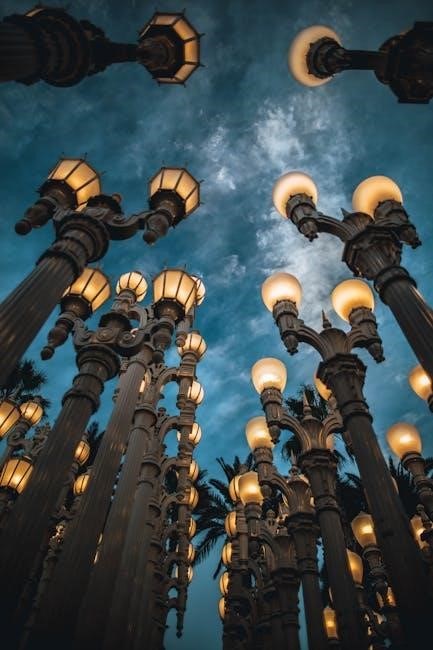The Secret History, Donna Tartt’s debut novel, is a literary masterpiece blending psychological thriller elements with dark academia. Its exploration of morality, beauty, and human flaws captivates readers globally, with the PDF version remaining widely popular for its accessibility and enduring appeal.

1.1 Overview of the Novel
The Secret History, Donna Tartt’s debut novel, is a gripping psychological thriller that delves into the darker aspects of human nature. Published in 1992, the story follows Richard Papen, a young man from California who enrolls in an elite college in New England. There, he becomes infatuated with a group of intellectual and enigmatic students studying Classics under the charismatic Professor Julian Morrow. As Richard immerses himself in their world, the group’s dynamics shift, leading to a tragic event—a murder—that binds them together in secrecy. The novel explores themes of morality, guilt, and the pursuit of beauty, weaving a tale of privilege, obsession, and the devastating consequences of their actions. Tartt’s rich prose and atmospheric storytelling create a haunting narrative that has captivated readers for decades, making The Secret History a modern classic in literary fiction.
1.2 Importance of the PDF Version
The PDF version of The Secret History has become a popular format for readers due to its convenience and accessibility. As a digital file, it allows readers to access the novel across multiple devices, making it ideal for those who prefer e-reading. The PDF format preserves the original text’s integrity, ensuring that Donna Tartt’s rich prose and atmospheric storytelling remain unchanged. Additionally, the PDF version is widely available for free download, making it a cost-effective option for readers worldwide. Its popularity has grown significantly, especially among fans of dark academia and psychological thrillers. The ease of sharing and storing the PDF has also contributed to its widespread dissemination, ensuring that Tartt’s masterpiece reaches a broader audience. This format has played a crucial role in keeping the novel relevant in the digital age, allowing new generations of readers to discover its haunting and thought-provoking narrative.

Author Background: Donna Tartt
Donna Tartt, born in 1963 in Mississippi, is a renowned American author known for her lyrical prose and deep psychological insights. She studied at the University of Mississippi and Bennington College, later gaining acclaim with her debut novel, The Secret History, which became a bestseller and solidified her reputation as a literary talent. Her work often explores themes of morality, beauty, and human complexity, as seen in her Pulitzer Prize-winning novel, The Goldfinch.
2.1 Early Life and Education
Donna Tartt, the acclaimed author of The Secret History, was born in 1963 in Greenwood, Mississippi. Her early life was marked by a deep love for literature, fostered by her family. Tartt pursued higher education at the University of Mississippi, where she began to develop her writing skills. She later transferred to Bennington College in Vermont, a hub for artistic and intellectual growth. This period significantly shaped her literary style and thematic interests. Her upbringing in the South and her academic experiences influenced her exploration of human psychology and moral complexity, which are central to The Secret History. Tartt’s educational background laid the foundation for her unique storytelling ability and philosophical depth, setting the stage for her successful literary career.
2.2 Literary Career and Major Works
Donna Tartt’s literary career is marked by her ability to craft compelling, atmospheric novels that explore deep psychological and philosophical themes. Her debut, The Secret History, published in 1992, became an instant bestseller and established her as a major literary voice. The novel’s success was unprecedented, staying on bestseller lists for thirteen weeks and being translated into numerous languages. Following this, Tartt published The Little Friend in 2002, a haunting tale of loss and redemption, and The Goldfinch in 2013, which won the Pulitzer Prize for Fiction. Her works are known for their intricate storytelling, rich prose, and exploration of human morality. Tartt’s writing style, often described as both elegant and dramatic, has captivated readers worldwide, solidifying her reputation as one of the most influential authors of her generation.
Plot Summary of “La Historia Secreta”
The Secret History follows Richard Papen, a young man from California, as he enrolls in Hampden College. He becomes infatuated with a group of privileged students studying Classics, leading to a tragic murder that unravels their lives, exploring themes of morality, guilt, and the darker side of human nature.
3.1 Main Characters and Their Roles
The novel revolves around a group of elite college students, each with distinct personalities and roles. Richard Papen, the narrator, is a Californian outsider seeking sophistication. Charles and Camilla Macaulay, twins with a complex bond, embody privilege and beauty. Francis Abernathy, sensitive and artistic, struggles with identity, while Bunny Corcoran, the group’s outsider, disrupts their dynamics. Each character’s flaws and desires intertwine, driving the tragic events. Their interactions explore morality, guilt, and the darker side of human nature, creating a gripping psychological narrative.

3.2 Key Events and Turning Points
The Secret History unfolds with a series of pivotal events that shape its dark narrative. The novel begins with Richard Papen’s arrival at Hampden College, where he becomes infatuated with a group of elite classics students. Their shared obsession with classical ideals and their isolation from the rest of the world create a tense atmosphere. A tragic event—the murder of one of their own—serves as the central turning point, unraveling the group’s dynamics and exposing their moral decay. The aftermath reveals the psychological unraveling of each character, as guilt and paranoia consume them. These events are intertwined with themes of beauty, morality, and the consequences of unchecked ambition, making the novel a gripping exploration of human frailty and the darker side of academia.

Themes and Symbolism
The novel explores morality and guilt, intertwined with the duality of beauty and its darker implications, symbolizing the destructive power of human flaws and the pursuit of an idealized existence.
4.1 Morality and Guilt
The Secret History delves deeply into the complexities of morality and guilt, exploring how characters justify their actions despite their darker implications. The novel portrays a group of privileged students grappling with the consequences of their decisions, blurring the lines between right and wrong. Richard Papen’s narrative voice reflects on the concept of a “fatal flaw,” suggesting that inherent imperfections drive individuals toward tragic outcomes. Guilt is a pervasive theme, as the characters’ pasts and insecurities shape their choices, leading to a downward spiral of self-deception and moral ambiguity. Tartt’s prose masterfully captures the psychological tension, highlighting how beauty and intellect can coexist with profound moral decay. The novel challenges readers to question whether the characters are inherently bad or merely victims of their own flaws, leaving a haunting impression of the weight of guilt and its irreversible consequences.
4.2 Beauty and Its Dark Side
The Secret History intricately explores the duality of beauty, presenting it as both a source of inspiration and a destructive force. The novel’s characters are deeply enamored with classical aesthetics and intellectual pursuits, idealizing beauty as a form of transcendence. However, this obsession with beauty is juxtaposed with its darker, more sinister aspects. The group’s fixation on perfection and their elitist worldview lead them to justify morally questionable actions, revealing how beauty can mask underlying ugliness. Tartt’s vivid descriptions of their refined tastes and intellectual arrogance contrast sharply with the grim reality of their actions, illustrating how beauty can be both a creative and destructive force. This theme is central to the novel, as it challenges readers to confront the idea that beauty, when taken to extremes, can lead to devastating consequences, blurring the line between light and darkness.
Psychological Aspects
The Secret History delves into psychological depth, exploring the fatal flaw concept and group dynamics. The characters’ isolation and intellectual arrogance lead to tragic consequences, revealing the darker side of human nature.
5.1 The Concept of Fatal Flaw

In The Secret History, Donna Tartt masterfully explores the concept of the fatal flaw through her characters’ psychological depths. Richard Papen’s relentless pursuit of an idealized life, driven by his Californian upbringing, exemplifies this idea. His desire to escape mundane reality leads him to a group of elite students, where his flaws intertwine with theirs. Each character—Francis’s vulnerability, Camilla’s detachment, and Bunny’s naivety—illustrates how inherent weaknesses precipitate tragedy. The novel shows how these flaws, amplified by isolation and group dynamics, culminate in a moral collapse. Tartt’s portrayal of these flaws not only propels the plot but also serves as a profound commentary on human nature, revealing how even the most refined individuals can succumb to darkness. This exploration of fatal flaws remains a central theme, making the novel a gripping psychological study. The PDF version of The Secret History captures this complexity, offering readers a haunting reflection on morality and consequence.
5.2 Group Dynamics and Isolation
In The Secret History, Donna Tartt delves into the destructive power of group dynamics and isolation. The novel’s central characters form a tightly knit group of intellectual elites, bound by their shared fascination with classical studies. Their isolation from the broader world fosters an “us versus them” mentality, intensifying their sense of superiority and moral disconnection. This insularity leads to a dangerous collective mindset, where the group rationalizes their actions, culminating in tragic consequences. Tartt explores how isolation breeds a toxic environment, where individuals lose their moral anchors and succumb to the pressures of group conformity. The PDF version of the novel highlights these dynamics, offering readers a chilling insight into how isolation can warp human behavior. Through this lens, Tartt examines the psychological effects of exclusion and the devastating consequences of unchecked groupthink, making The Secret History a profound study of human frailty and collective guilt.

Cultural and Historical Context
The Secret History is set in an elite academic environment, reflecting the cultural fascination with classical literature and the darker aspects of intellectual elitism, resonating with both historical and contemporary themes.
6.1 Setting and Atmosphere
The setting of The Secret History is deeply intertwined with its atmosphere, creating a sense of isolation and foreboding. The story unfolds in the privileged environment of an elite New England college, where the characters’ detachment from the outside world heightens the novel’s dark, introspective mood. The campus, with its classical architecture and secluded surroundings, serves as a backdrop for the characters’ intellectual and moral struggles. The atmosphere is heavy with tension, reflecting the characters’ inner turmoil and the weight of their secrets. Tartt’s vivid descriptions of the changing seasons and the stark beauty of the landscape contrast sharply with the ugliness of the events that unfold, adding to the novel’s haunting and immersive quality. This interplay between setting and atmosphere is central to the novel’s exploration of morality, beauty, and the darker aspects of human nature.
6.2 Influence of Classical Literature
The Secret History is deeply influenced by classical literature, particularly Greek tragedy and philosophy. Donna Tartt weaves elements of classical texts into the narrative, reflecting the characters’ obsession with ancient studies. The novel’s focus on morality, guilt, and the fatal flaw mirrors themes found in works like Euripides’ The Bacchae. The characters’ pursuit of intellectual and aesthetic perfection echoes classical ideals, while their descent into darkness aligns with tragic archetypes. Tartt’s use of classical motifs underscores the timelessness of human struggles, bridging ancient and modern worlds. This literary approach not only enriches the story but also highlights the enduring relevance of classical themes in contemporary fiction. The PDF version of the novel retains these layers of meaning, offering readers a profound exploration of how ancient ideas shape modern human experiences. This blend of classical influence and modern storytelling is a hallmark of Tartt’s literary style.
Availability and Formats
The Secret History is widely available in various formats, including hardcover, paperback, and digital versions. The PDF version is particularly popular, offering readers a convenient and accessible way to enjoy the novel. Websites like OceanofPDF.com provide free downloads, making it easy for fans to access Donna Tartt’s masterpiece. The PDF format ensures that the novel’s rich prose and atmospheric storytelling are preserved, allowing readers to immerse themselves in the dark academia and moral complexities of the narrative. This accessibility has contributed to the book’s enduring popularity and widespread readership.
7.1 The Secret History PDF Version
The Secret History PDF version has become a popular choice for readers worldwide due to its convenience and accessibility. Available on platforms like OceanofPDF.com and Z-Library, the file is easily downloadable, offering a seamless reading experience. The PDF format preserves the novel’s original structure and formatting, ensuring readability on various devices. With a file size of 2.6 MB, it is lightweight yet complete, containing all 602 pages of the original text. The PDF has gained traction among fans of dark academia and classical literature, as it allows for easy highlighting and note-taking. Its availability in multiple languages, including Spanish as La Historia Secreta, has further expanded its reach. The PDF’s clarity and professional layout make it a preferred option for both casual readers and academic purposes, ensuring Donna Tartt’s masterpiece remains accessible to a global audience.
7.2 Free Download Options
For readers seeking convenient access, the Secret History PDF is available for free download on various platforms. Websites like OceanofPDF.com and Z-Library offer the novel in PDF format, allowing readers to access Donna Tartt’s masterpiece without cost. The file, sized at 2.6 MB, is lightweight and compatible with most devices, ensuring easy readability. Additionally, platforms like Z-Library provide options to download the PDF in multiple formats, such as .txt, catering to different reader preferences. The availability of La Historia Secreta in Spanish further broadens its accessibility. These free download options have made the novel more approachable, enabling a global audience to engage with its compelling narrative and themes. The ease of access has contributed to its enduring popularity, making it a staple in both academic and casual reading circles.

Reader Reception and Reviews

The Secret History has garnered widespread critical acclaim for its profound exploration of morality and human complexity. Readers praise its atmospheric prose and haunting narrative, with many rating it highly for its psychological depth and timeless themes.
8.1 Critical Acclaim and Ratings
The Secret History has garnered widespread critical acclaim since its release in 1992. Reviewers praise its intricate storytelling, rich prose, and deep psychological insight. The novel holds a 4.5-star average rating on platforms like Goodreads, with many hailing it as a modern classic. Critics highlight its ability to blend elements of a psychological thriller with literary fiction, creating a compelling narrative that explores themes of morality and guilt. The book’s atmospheric setting and well-developed characters have been particularly praised. Its success led to it becoming a bestseller, staying on the New York Times bestseller list for 13 weeks. The PDF version has further amplified its reach, making it accessible to a global audience. Fans and critics alike commend Donna Tartt’s masterful storytelling, solidifying the novel’s place in contemporary literature.
8.2 Reader Opinions and Discussions
Readers worldwide have expressed strong opinions about The Secret History, praising its deep exploration of human nature and moral complexity. Many describe it as a haunting yet mesmerizing read, with its dark academia theme resonating particularly with younger audiences. The PDF version has made the novel more accessible, sparking lively discussions in online forums and book clubs. Fans often debate the morality of the characters’ actions and the concept of the “fatal flaw.” The novel’s ability to evoke strong emotions has led to it being labeled a “modern classic” by many readers. Its exploration of beauty and its darker side has also been a focal point of discussion. The book’s enduring popularity is evident in its consistent ratings and the passionate debates it continues to inspire, solidifying its place as a favorite among both casual readers and literary enthusiasts.

The Book’s Legacy
The Secret History has left an indelible mark on modern literature, influencing the dark academia genre and inspiring countless readers. Its timeless themes ensure its relevance and enduring popularity.
9.1 Impact on Modern Literature
The Secret History has left an indelible mark on modern literature, redefining the boundaries of psychological fiction and dark academia. Its intricate storytelling and profound exploration of human morality have inspired countless authors, shaping the genre’s evolution. The novel’s ability to blend intellectual depth with gripping narrative has set a new standard for literary thrillers. Its influence is evident in contemporary works that explore similar themes of guilt, beauty, and the darker aspects of human nature. The PDF version’s widespread availability has further cemented its reach, making it a staple in digital libraries and a favorite among readers seeking thought-provoking fiction. As a result, Donna Tartt’s masterpiece continues to resonate, solidifying its place as a cornerstone of modern literary culture.
9.2 Comparison with Other Works
The Secret History is often compared to Donna Tartt’s other works, such as The Goldfinch, for its deep psychological insight and atmospheric storytelling; While The Goldfinch explores trauma and redemption, The Secret History delves into morality and the darker aspects of human nature. Similarly, it draws parallels with Bret Easton Ellis’s American Psycho in its exploration of privilege and moral decay, though Tartt’s prose is more lyrical and introspective. The novel’s blend of classical influences and modern themes also evokes comparisons to works by authors like F. Scott Fitzgerald, who similarly examined the complexities of elite societies. However, The Secret History stands out for its unique voice and its ability to merge literary fiction with the suspense of a thriller, making it a standout work in contemporary literature.
The Secret History, a modern classic and psychological thriller, explores morality, beauty, and darkness. Its PDF version remains popular, offering a haunting tale of human complexity and fatal flaws.
10.1 Final Thoughts on the Novel
The Secret History by Donna Tartt is a profound exploration of human nature, morality, and the consequences of actions. Its intricate characters and atmospheric storytelling leave a lasting impression, making it a modern classic. The novel’s ability to blend psychological depth with a gripping narrative has solidified its place in literary history. Themes of beauty, guilt, and the darker aspects of human behavior resonate deeply, offering readers a thought-provoking experience. The PDF version ensures accessibility, allowing a wider audience to engage with this masterpiece. Ultimately, The Secret History is a haunting yet elegant tale that lingers in the mind long after the final page, leaving readers to ponder the complexities of human frailty and the enduring power of storytelling.
10.2 Recommendations for Readers
Readers drawn to dark academia, moral complexity, and psychological depth will find The Secret History captivating. The novel’s intricate characters and atmospheric prose make it a must-read for fans of literary fiction. Those interested in exploring themes of guilt, beauty, and the human condition will appreciate its profound insights. The PDF version is ideal for readers who prefer digital formats, offering convenience and accessibility. For first-time readers, it’s advisable to immerse yourself in the narrative without rushing, as the novel’s richness lies in its layered storytelling. Additionally, readers may benefit from reflecting on the novel’s classical influences and its modern-day relevance. Overall, The Secret History is a thought-provoking read that lingers long after the final page, making it a worthwhile experience for both casual and discerning readers alike.
